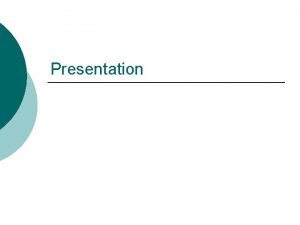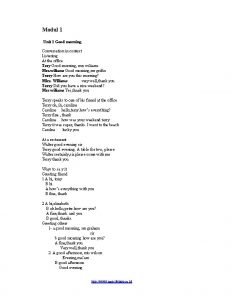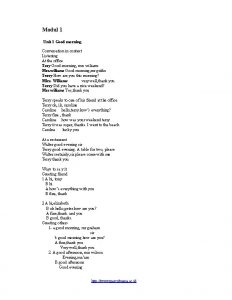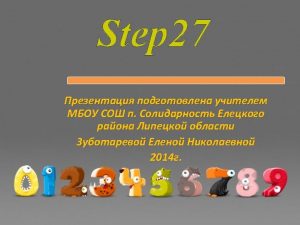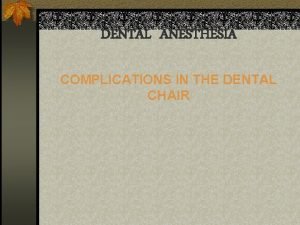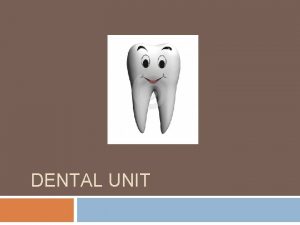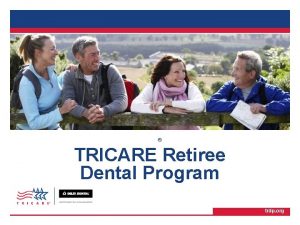GOOD MORNING SCHOOL DENTAL HEALTH PROGRAM INTRODUCTION School


























































































- Slides: 90

GOOD MORNING

SCHOOL DENTAL HEALTH PROGRAM

INTRODUCTION School health is an important aspect of public health. It is an economical and powerful means of raising community health in future generations. 19 th century - Dentist William Fisher of England observed high caries experience and lack of treatment among children, hence he devoted much time campaigning for compulsory inspection and treatment of children in schools 25 -09 -2020 3

July 23 rd 1898 - School Dentists Society was formed in London. School Health Service in INDIA dates back to 1909 - when for the first time medical examination of school children was carried out in Baroda City. 1953 - the Secondary Education Committee emphasized the need for school nutrition programs. 25 -09 -2020 4

1960 - the Government of India constituted a School Health Committee, and submitted its report in 1961. January 1982 - a Task Force constituted by the Government of India to propose an intensive School Health Service Project, submitted its report July 19 th 2001 - The “Tokyo Declaration” was made on at the 1 st Asian Conference on Oral Health Promotion for School Children, held in Tokyo. 25 -09 -2020 5

• February 23 rd 2003 - The “Ayutthaya Declaration” was made at the 2 nd Asian Conference of Oral Health Promotion for School Children held in Ayutthaya, Thailand. • January 28 th 2005 The “Bangalore declaration” was made at the CAMHADD/WHO workshop on prevention and promotion of oral health through schools held at Bangalore. 25 -09 -2020 6

DEFINITION 25 -09 -2020 7

School health services are defined as the “procedures established • to appraise the health status of pupils and school personnel, • to counsel pupils, parents, and others concerning appraisal findings, • to encourage the correction of remediable defects, 25 -09 -2020 8

• to assist in the identification education of handicapped children • to help prevent and control disease and to provide emergency service for injury or sudden sickness. (By The Committee on Terminology of The American Association for Health, Physical Education, and Recreation 1951) 25 -09 -2020 9

PRINCIPLES OF SCHOOL HEALTH SERVICE

HEALTH APPRAISAL It is defined as “the process of determining the total health status of child through such means as health histories, teacher and nurse observations, screening test; and medical, dental and psychological examinations”.

HEALTH COUNSELING Defined as “the procedure by which nurse, teachers, physicians, guidance personnel, and others interpret to pupils and parents, the nature and significance of the health problem and aid them in formulating a plan of action which will lead to solution of the problem”. Eg; elimination of sales of candy and sweetened beverages in school

EMERGENCY CARE AND FIRST AID: Since teachers are the first to realize any emergency in school, they should be trained in handling simple emergencies such as traumatic injuries to teeth during contact sports.

SCHOOL HEALTH EDUCATION: It is the process of providing learning experiences for the purpose of influencing knowledge, attitude, or conduct relating to individual or community health.

It should cover the aspects of: • Personal hygiene • Environmental health and • Family life.

MAINTENANCE OF SCHOOL HEALTH RECORDS These records are useful in analyzing and evaluating school health programs and to provide a useful link between the home, the school and the community.

CURATIVE SERVICES They include regular dental checkups and prompt treatment wherever possible and referral for special problems

PRINCIPLES OF SCHOOL DENTAL HEALTH PROGRAM To help every school child appreciate the importance of a healthy mouth. To help every school child appreciate the relationship of dental health to general health and appearance. To encourage the observance of dental health practices, including personal care, professional care, proper diet, and oral habits.

To enlist the aid of all groups and agencies interested in the promotion of school health. To correlate dental health activities with the total school health program. To stimulate the development of resources to make dental care available to all children and youth. To stimulate dentists to perform adequate health services for children.

IDEAL REQUIREMENTS

A school dental health program should ü Be administratively sound ü Be available to all children ü Provide the fact about dentistry and dental care, especially about self-care preventive procedures ü Aid in the development of favorable attitudes dental health

ü Provide the environment for the development of psychomotor skills necessary for tooth brushing and flossing ü Include primary preventive dentistry programsprophylaxis, fluoride program and use of pit and fissure sealants ü Provide screening methods for the early identification and referral to pathology ü Ensure that all discerned pathology is expeditiously treated.

School Dental Health Program

• Programs can bring comprehensive dental health care including preventive measures to school children where they are gathered anyway for non-dental reasons in the largest possible numbers- advantageous in dentist deprived areas • Students can be accessed during their formative years from childhood to adolescence. These are important stages in people’s lives when lifelong oral health related behavior as well as beliefs and attitudes are being developed.

• School clinics are less threatening than private offices since the children are in familiar surroundings • The children’s daily contact with the dental personnel in other roles, such as joining with the teachers in a variety of school activities, may have a lasting effect in their attitudes towards dentistry in general.

• If the children can be maintained in a state of good dental health it will be relatively easy to maintain their dental health in adult life. • A regular dental attendance pattern in early life will be continued after the school age. • School dental health programs when associated with general health programs can facilitate valuable consultation on medico-dental problems

• The expenses involved and the time used in transportation to private dental office can be saved if the child gets dental care in the school itself. • If parents have to escort children to a private dental office, he/she will lose income for that day. This can be overcome by school dental health programs. • Utilizing dental auxiliaries can further reduce the cost. • The health of school staff, families and community members can be enhanced by programs based in schools.

Thank you

GOOD MORNING

ELEMENTS/COMPONENT OF SCHOOL DENTAL HEALTH PROGRAM

IMPROVING SCHOOL COMMUNITY RELATION One of the first steps in organizing a dental health program is the formation of advisory committee. It should include broad representation from parents, teachers, school administrators, dental professionals, health officers and community leaders.

The task of these committees is • To apprise and publicize the dental needs of the school children • To address the school administration’s concern in the promotion of oral health. • To make people realize the importance of dental health.

CONDUCTING DENTAL INSPECTIONS • It serves as a basis for school dental health instruction. • Every child unless proved otherwise is considered to be free from dental disease , the positive findings, on such children will provide greater motivation towards dental health.

• It builds a positive attitude in the child towards the dentist and dental care. • The child and the parent are motivated to seek adequate professional care • Teacher, students, and dentists concerned with dental health may use the dental inspection as a factfinding experience.

• Baseline and cumulative data for evaluation of the school dental health program are made available. • Provide information as to the status of dental needs to plan a sound dental health program.

CONDUCTING DENTAL HEALTH EDUCATION • The dentist serves as the expert resource person to strengthen the teacher’s classroom instruction program. • He should give each teacher sincere attention. • This is important in developing proper attitudes and personal dental health practices by the teacher which can be passed on to the classroom.

PERFORMING SPECIFIC PROGRAMS 25 -09 -2020 37

TOOTH BRUSHING PROGRAMS • In the classroom, 6 -8 children can be taught as a group. Each is given a cup, a napkin, and a kit containing a : disclosing tablet, a toothbrush, and a tube of fluoride dentifrice. • The mastery of the 45 degree angulations and the short vibratory strokes can then be repeated on an oversized dentoform model.

• Next, the children are asked to chew a disclosing tablet and to swish it around the mouth for 30 seconds. • They are then encouraged to look at each others teeth with appropriate emphasis on the fact that the red stain colors the plaque in which the bacteria live.

• Next a magnifying mirror is passed around so the participants can note that their teeth are no different from those of their neighbor i. e. all people have plaque. • Guided brushing can then begin, with the instructor establishing the sequence of teeth to be brushed. • At the end, the mirror is again passed around to show that progress has been made.

CLASSROOM-BASED FLUORIDE PROGRAMS: Fluoride ‘mouth-rinse’ program Fluoride mouth- rinse programs received official recognition of safety from the FDA in 1974 and by council on dental Therapeutics of the ADA in 1975.

A once-a-week mouth rinse can be expected to result in 20% to 40% reduction in dental caries. The dispenser is graduated so that 2. 0 gm. of packaged sodium fluoride powder can be placed in a jug and water is added to the 1000 -ml mark. The rinse should be non-sweetened and nonflavored to discourage swallowing.

• Rinsing programs are advised for grades 1 to 12 but not below. • 5 ml of the rinse is dispensed in to each cup and all the children are instructed to rinse the solution in the mouth for 1 minute, after which they are to spit carefully in to the cup. • The napkin is used to wipe the mouth, after which it is forced into the bottom of the cup to absorb all fluid

Fluoride tablet program: • One tablet is given to each student. The student then chews and swishes the 2. 2 mg sodium fluoride (1 mg fluoride) tablet in the mouth for a minute and then swallows.

• The swish-and-swallow technique provides the optimum systemic benefit during the period of tooth development and maturation. • The daily tablet is more effective than the weekly rinse.

SCHOOL WATER FLUORIDATION PROGRAMS • The amount of fluoride added to school drinking water must be greater than that used in communal water supplies, i. e. 4. 5 times the optimum concentration since children are in school for shorter hours and less water is consumed during that time. • Study have shown a reduction in Dental Caries prevalence by about 40% among children attending school that support school water fluoride programs

NUTRITION AS A PART OF SCHOOL PREVENTIVE DENTISTRY PROGRAMS: School lunch programs are designed to provide the child with an intake of nutrients that approximate one third of the daily intake of essential carbohydrates, proteins, fat, minerals and vitamins.

MID DAY MEAL PROGRAM OF GOVERNMENT OF INDIA • The program of providing hot cooked meal was introduced in 7 north eastern districts of the state during 2002 -2003. • Akshara Dasoha -2003 -2004

• The scheme consisted of providing free food grains at 3 kg per child/per months to children of class 1 to 5 of government schools on the basis of 80% of attendance in a month. • The scheme was extended to classes 1 to 5 in Government aided schools from 1 -9 -2004 and to class 7 and 8 in Government/Government Aided Schools from 1 -10 -2004

The objectives of the program • To improve enrolment and attendance • To reduce school drop outs. • To improve child health by increasing nutrition level. • To improve learning levels of children. The hot cooked food contains about 400 calories (per child per day) Rice - 100 gms Pulses - 20 gms Oil & fat - 05 gms Vegetables - 50 gms Salt - as needed

SEALANT PLACEMENT

: • The placement of pit-and-fissure sealants is ideally suited for a school program. • 1 st, 2 nd, 6 th and 7 th standards would be desirable levels to selectively intervene to prevent pits-and-fissure lesions. • 1 st and 2 nd standards, because first permanent molars are sufficiently erupted to place the sealant. 6 th and 7 th standards-2 nd permanent molars.

SCIENCE FAIRS Science fair not only helps in educating and motivating school children to improve their oral health but also provides an excellent opportunity for dentistry to contribute substantially to the building of a growing reservoir of students who may some day choose a career in dentistry.

REFERRAL FOR DENTAL CARE • In few schools dental care is provided at the school itself. However if only emergency treatment is provided, for e. g. the dental auxiliary places eugenolsoaked cotton in a child’s cavity to relieve the pain , the parent does not see the child in pain and might conclude that the school has taken care of the dental problem. • Therefore the parent should be informed

“BLANKET” REFERRAL A program that has proved to be effective in many schools is “blanket” referral of all children to their family dentists.

In this program, all children are given referral cards to take home and subsequently to the dentist, who sign the cards upon completion of examination, treatment, or both. The signed cards are then returned to the school nurse, or classroom teacher, who plays an important role in following up the referrals with the child and parents

FOLLOW –UP The mere insurance of referral slips to children will be of little value if steps are not taken to make it clear that the school is interested in defect correction. This needs a good follow up system. The dental hygienist is the logical person to conduct such follow-up examinations

There are two reasons for such concessions: • The child is a more co-operative patient when medical/dental services are provided during early or middle part of the day. • Dentists can provide better services for children when they have time and do not have to crowd their child patients into after school hours.

Thank you

Good Morning

SCHOOL DENTAL HEALTH PROGRAMS AROUND THE WORLD

: “LEARNING ABOUT YOUR ORAL HEALTH” A PREVENTION ORIENTED SCHOOL PROGRAM: This program was developed by the American Dental Association and their consultants in co-ordination with the 1971 ADA house of delegates and is presently available to school systems throughout the United States of America. “Learning About Your Oral Health” is a comprehensive program covering current dental concepts.

THE PRIMARY GOAL OF THIS PROGRAM • To develop the knowledge, skills, and attitudes needed for prevention of dental diseases among school children

Implementation of the program: • The program is divided in to five levels • Preschool (designed for children too young to read). Level I (kindergarten through grade 3). Level II (grades 4 through 6). Level III (grades 7 through 9). Level IV (grades 10 through 12).

Each teaching packet includes • A teacher’s self-contained guide on “dental health facts” with a section on handicapped children • A glossary of dental health terms • A curriculum guide featuring content, goals, behavioral objectives and suggested activities for the preschool level and seven or more lesson plans for each of the other levels • Four overhead transparencies • Twelve spirit masters( for copying) • Methods and activities for parental involvement.

“TATTLETOOTH PROGRAM” TEXAS STATEWIDE PREVENTIVE DENTISTRY PROGRAM

The Tattle tooth program was developed in 1974 -1976 as a cooperative effort between Texas DENTAL health professional organizations, the Texas Department of Health and the Texas Education Agency through a grant from the Department of Health and Human Services to the Bureau of Dental Health. The program was pilot tested in 1975 and field tested in spring 1976 in schools within the states of Texas. Separate lesson plans were developed for each grade and a systems approach was used to develop all educational material.

• Three videotapes were produced as part of the teachertraining package. • The first videotape familiarizes the teacher with the lesson format and content. • A second videotape, “Brushing & Flossing” was developed for the dual purpose of teacher training & as an educational unit to be used by the teacher with the students. • A third videotape provides teachers with additional background information as a means of preparing them to teach the lessons.

• The materials that were developed to aid in the implementation of the program consisted of ØA brochure that provides an overview of the program. ØA school nurses brochure. A letter to school principals & nurses was sent out as part of a package distributed annually by the Bureau of Maternal & Child Health. A two hour training session using the materials in the new curriculum was televised to the schools via a video network

Program Implementation: The Texas Department of health employs 16 hygienists in the eight public health regions to implement the Tattletooth program. • The hygienist instructs teachers using videotapes designed for teacher training & provide them with a copy of the curriculum. • Health promotion activities are encouraged & publicized within the school community. • Teachers are encouraged to invite a dental professional to demonstrate brushing & flossing in the classroom.

• A field trip to a dental office is strongly recommended for kindergarten children. • Bulletin board suggestions, a book list, films & videotapes are available on a free loan for appropriate grade levels. • Other resources used are a list of companies providing supplementary classroom resources & a comprehensive glossary of vocabulary words written for the teacher in English that are used in all grades levels.

The students in grades 3, 5, 7, 9 and 11 were given the Taxes Assessment of Academic Skills (TAAS) by the Taxes Education agency, to satisfy the legislative requirement that student performance be assessed. • Dental health knowledge was significantly increased at all grades levels. • Plaque levels were decreased by approximately 15% in a randomly selected sample of 2, 142 children. • Over 80%of the teachers judged the program to be helpful and effective, but evaluation questions suggested that they felt a need for additional technical help in brushing and flossing.

ASKOV DENTAL DEMONSTRATION: Askov is a small farming community with a population mostly of Danish extraction. It showed very high dental caries in the initial surveys made in 1943 and 1946. Department of health supervised a demonstration school dental health program in Askov, including caries prevention and control, dental health education and dental care. •

• All recognized methods for preventing dental caries were used in the demonstration with the exception of communal water fluoridation since until 1955 Askov had no communal water supply. • Dental care was rendered by a group of five dentists from nearby communities employed by the Minnesota department of health. These dentists also gave topical fluoride treatments.

Findings available through a 10 year period revealed • 28% reduction in dental caries in deciduous teeth of children aged 3 to 5 years. • 34% reduction in caries in the permanent teeth of children 6 to 12 years old. • 14%reduction in permanent teeth of children 13 to 17 year old. • Improvements in filled-tooth ratios.

The cost of the program was greater and the caries reduction smaller when compared with fluoridation. However fluoridation is by no means a substitute for such a program. Good health habits are valuable even for persons with resistant teeth and dental care for the indigent is still needed in fluoridated areas.

NORTH CAROLINA STATEWIDE PREVENTIVE DENTAL HEALTH PROGRAM In 1970, the North Carolina Dental Society passed resolution advocating a strong preventive dental disease program embracing school and community fluoridation, fluoride treatments for school children, plaque control education in schools and communities and continuing education on prevention for dental professionals.

• A steering committee developed a practical plan for a program in the schools. This was the first statewide program of its magnitude. • Continuation and expansion of the North Carolina Preventive Dentistry program for Children (NCPDPC) has been made possible through incremental funding through grants awarded by Kate. B. Reynolds Health care Trust. • These projects include producing 19 videotapes for classroom teachers in teaching dental health and conducting a representative sample of North Carolina schoolchildren from kindergarten through grade 12 during the 1986 -87 school years.

Objectives that will facilitate attainment of the goals include: • Appropriate use of fluoride • Health education in schools and communities • Availability of public health dental staff in all counties

Program implementation: In 1990 , services delivered through the program include • The fluoridation of water supplies of 130 rural schools, • Weekly fluoride mouth rinse for more than 416, 000 students in 1, 051 schools • Dental health education was presented to 361, 000 children and 42, 000 adults. • Screening and referral for more than 339, 000 children. • More than 33, 000 dental sealants were applied.

Program evaluation: • 34%reduction in decayed, missing and filled permanent teeth among children who had 8 years experience drinking fluoridated water at school. • 53% reduction in decayed, missing and filled permanent teeth among children who had 10 years experience drinking fluoridated water • 86% reduction in dental caries after 4 years of sealant use on permanent teeth.

HEAD START –PRE-SCHOOL DENTAL HEALTH PROGRAM: §Head start is a program of the United states Department of Health and Human Services initiated in 1965 §Focuses on assisting children from low-income families. §longest-running program for stopping the cycle of poverty in US § provides comprehensive education, health, nutrition, and parent involvement services to low-income children and their families.

SCHOOL HEALTH ADDITIONAL REFERRAL PROGRAMME (SHARP): Instituted in Philadelphia with the purpose of motivating parents into initiating action for correction of defects in their children through effective utilization of community resources.

§The project was carried out by district nurses with the co-operation of school personnel. §The nurses made daytime visits to families in which the mothers were at home. §Working parents were contacted by phone. §The one-to-one basis of health guidance between parent and health worker established better rapport between school and home.

TEENAGE HEALTH EDUCATION TEACHING ASSISTANTS PROGRAM (THETA Program) Developed by the National Foundation for the prevention of oral disease for the US Department of Health and welfare, Division of Dental Health. Philosophy §Dental personnel train high school children to teach preventive dentistry to elementary school children.

Goals • To give knowledge & skills to young children • Allows high school children to develop understanding of young children • Introduces them to career opportunities

COLGATE’S BRIGHT SMILES, BRIGHT FUTURES

§The Colgate Bright Smiles, Bright Futures” 0 ral health educational program worldwide was developed to teach children positive oral health habits of basic hygiene, diet & physical activity. § This program also encourages dental professionals, public health officials, civil leaders & most importantly, parents & educators to come together to emphasize the importance of oral health as part of a child’s overall physical & emotional development.

§Under this program, children in primary school receive instructions in dental care from members of the dental profession nominated by the Indian Dental Association §Education is imparted with the aid of audio visuals and printed literature. §Free dental health care packs are distributed to encourage good oral hygiene.

Thank you!
 Good evening students
Good evening students Teacher:good morning class
Teacher:good morning class Good afternoon, teacher
Good afternoon, teacher Good morning class!
Good morning class! I am glad to be with you
I am glad to be with you Hello hi good evening
Hello hi good evening Good evening students
Good evening students Hello good morning
Hello good morning Gentleman good night ladies good morning
Gentleman good night ladies good morning Good morning revival
Good morning revival Good morning good lookin
Good morning good lookin Good evening teacher
Good evening teacher Ladies and gentlemen good evening
Ladies and gentlemen good evening Good morning introduction
Good morning introduction Good morning dear students
Good morning dear students That's all of my presentation
That's all of my presentation Good morning and welcome
Good morning and welcome Good thoughts good words good deeds meaning
Good thoughts good words good deeds meaning You are good when there's nothing good in me
You are good when there's nothing good in me Good morning public school
Good morning public school Good morning welcome
Good morning welcome Morning i see you in the sunrise
Morning i see you in the sunrise Are you sleeping father john
Are you sleeping father john National intervention programme for mother and child
National intervention programme for mother and child Objectives of school health programme
Objectives of school health programme Theta program in community dentistry
Theta program in community dentistry Morning to you song
Morning to you song In the afternoon i say good
In the afternoon i say good Receptionist hotel duta good morning can i help you
Receptionist hotel duta good morning can i help you Good morning and welcome back
Good morning and welcome back Good morning 1 june
Good morning 1 june Good morning ladies and gents
Good morning ladies and gents Good morning campers today's challenge is simple
Good morning campers today's challenge is simple Hello everyone today
Hello everyone today Good morning welcome june
Good morning welcome june 2 may good morning images
2 may good morning images Good morning one and all
Good morning one and all Teacher good morning student
Teacher good morning student Good morning flashcards
Good morning flashcards Good morning please have a seat
Good morning please have a seat Theobald von bethmann hollweg
Theobald von bethmann hollweg Thank you french
Thank you french Good morning florence
Good morning florence Teacher good morning everybody
Teacher good morning everybody Dear boys and girls
Dear boys and girls Good morning, class
Good morning, class Ileocal valve
Ileocal valve Goodmorning boys and girls
Goodmorning boys and girls Good morning, boys
Good morning, boys Ivo v
Ivo v Assistant good morning
Assistant good morning Good morning june 1
Good morning june 1 Good morning assalamualaikum
Good morning assalamualaikum Good morning campers today's challenge is simple
Good morning campers today's challenge is simple Goodmorning stay safe
Goodmorning stay safe Good morning welcome back
Good morning welcome back Hello friends good morning
Hello friends good morning Formal good morning
Formal good morning Good morning md
Good morning md Good morning students how are you
Good morning students how are you Good morning hr
Good morning hr Good morning everyone and welcome to my presentation
Good morning everyone and welcome to my presentation Morning jobs
Morning jobs Pictures of stich
Pictures of stich Good morning poetry
Good morning poetry Good morning elves
Good morning elves Good morning elves
Good morning elves Data access worldwide
Data access worldwide The desperate man
The desperate man Hello my name is first name bunch of numbers
Hello my name is first name bunch of numbers Good morning investors
Good morning investors Unit 1 good morning
Unit 1 good morning Good morning starter
Good morning starter Hello good morning what's your name jenny
Hello good morning what's your name jenny Hello. what _________ your name?
Hello. what _________ your name? Good morning in paraguay
Good morning in paraguay Good morning pics
Good morning pics Conversation good morning
Conversation good morning Good morning year 1
Good morning year 1 Hello im jenny
Hello im jenny Good morning tag question
Good morning tag question Good morning peacock
Good morning peacock Good morning with peacock
Good morning with peacock Good morning in science language
Good morning in science language Good morning mercy
Good morning mercy Well welcome to the class everybody
Well welcome to the class everybody Good morning everybody images
Good morning everybody images Engage activate study
Engage activate study Good morning elves
Good morning elves Place value song
Place value song Good evening have a seat
Good evening have a seat















